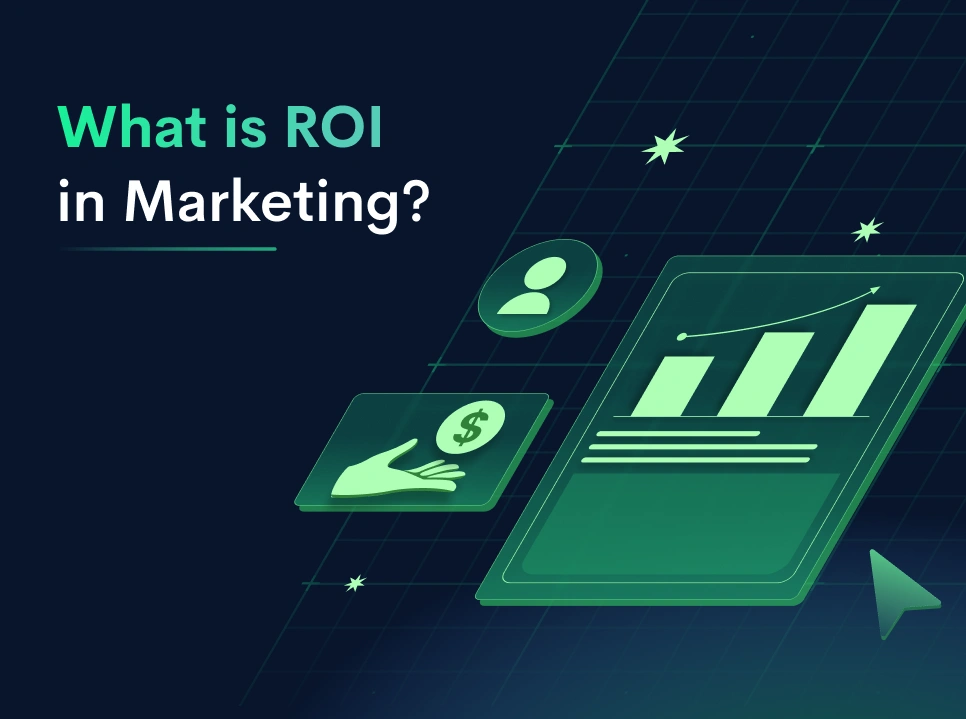ROI Marketing: Everything You Need to Know [2023]

ROI marketing has evolved from a buzzword to a strategic imperative. It now joins in the table of making decisions that shape the future of organizations. As companies strive to make data-driven choices, optimize their marketing budgets, and maximize the effectiveness of their campaigns, mastering the art of ROI marketing has become an essential skill.
What is ROI marketing? Is it different from the original ROI (Return on Investment)? How to calculate ROI marketing? Is this metric overrated?
You can find detailed answers to every question in this comprehensive article, where we demystify the intricacies of measuring, interpreting, and leveraging the ROI metric to propel your marketing efforts to new heights.
Let’s dive in!
| 💡 You might also like: |
What is ROI in Marketing?
1. What is ROI?
Return on investment (ROI) is a performance metric to evaluate the effectiveness or profitability of an investment or to compare the efficiency of various investments. ROI aims to showcase the returns of a specific investment with its initial cost.
Many companies usually use ROI to report their investment performance due to its adaptability and straightforward nature. ROI can serve as a basic indicator of an investment’s profitability.
For example: the ROI of a stock investment, a company’s forecasted ROI for expanding a factory, or the ROI of a real estate transaction.
One of the advantages is that ROI’s formula is too complicated, and its interpretation does not require the knowledge of a scientist. Once the result of the ROI calculation is net positive, it shows your investment might be worthwhile. On the other hand, if the ROI is negative, it warns you of a net loss.
2. Is ROI Marketing Different?
The definition of ROI above seems to focus more on the support of ROI for investors than for marketers. ROI marking does not have a different role from ROI as it evaluates how profitable your marketing investments are.
Marketing encompasses a company’s efforts to attract customers and nurture ongoing relationships. The primary concerns for companies regarding their marketing efforts revolve around determining the return on investment (ROI) they receive from their expenditures.
Organizations use this metric to determine how much their marketing efforts contribute to making more money. They usually use ROI marketing to make sure they spend their budget wisely and plan for future marketing campaigns.
How Can ROI Marketing Help Companies?
In general, ROI marketing meaning is how much every cent of your investments in marketing generates in profits. Yet, you should dive deeper into the insights ROI marketing provides to navigate current marketing efforts with timely adjustments effectively. You can also form a strong foundation for the following marketing projects.
1. Rationalize Marketing Costs
Company leaders often prioritize allocating resources and budgets for marketing activities. You should demonstrate the value of current marketing spend to ensure continued support and funding for future campaigns.
As a marketer, you can get a nod on a marketing budget by accurately calculating the ROI generated by their marketing efforts. For example, you assess whether specific tactics, like native ads, drive conversions and positive ROI, while others, such as display ads, may not be as effective. The power of data can support efficient budget allocation.
2. Allocate Marketing Budgets
Companies have many online and offline channels to choose from when planning their marketing mix. Understanding which online and offline strategies yield the highest revenue or even profit is crucial for making informed decisions about allocating the marketing budget effectively.
3. Assess Campaign Success and Set Benchmarks
Successful marketing teams must measure their campaigns’ success and establish performance benchmarks for future efforts. ROI marketing kills two birds with one stone.
The metric provides insights into how individual campaigns contribute to overall revenue growth; hence, marketers can fine-tune the balance between offline and online strategies. Consistent ROI tracking also allows them to establish reliable benchmarks for evaluating success and adapting strategies for maximum impact.
4. Competitive Analysis
Tracking competitors’ marketing ROI helps companies gauge their performance within their industry. Marketers can estimate competitors’ ROI by examining publicly available financial data and adjusting their benchmarks accordingly. This method keeps their marketing campaigns competitive and aligned with industry standards.
What is a Good ROI Marketing?
Establishing a standard benchmark for marketing ROI is complex due to the intrinsic diversity of marketing tactics.
In cases involving online advertising strategies like Pay-Per-Click (PPC), where you can track ROI data automatically, you may find it relatively straightforward to compare the returns of your ads with those similar to yours. Platforms such as Google Ads, with their extensive historical data, may provide an established benchmark, such as 800% ROI.
When dealing with other strategies like content marketing, you might encounter difficulties with discerning a direct link between efforts like blog posts, podcasts, or videos and immediate purchases. According to the Content Marketing Institute (CMI), the challenge has perplexed marketers for decades. Despite advancements like tracking URLs and technology, CMI suggests that measuring ROI in content marketing still requires a long-term perspective and an acknowledgment of non-financial gains, including audience growth.
For most businesses, a practical approach to setting a “good ROI” benchmark for each marketing strategy involves examining the returns from similar tactics employed in the past alongside current sales figures. The data should assist in creating realistic ROI benchmarks and goals tailored to your company’s circumstances.
How to Calculate ROI Marketing?
1. ROI (Return of Investment) Formula
| ROI = Current Value of Investment − Cost of Investment Cost of Investment |
Current Value of Investment represents the earnings from the sale of the investment in question. Since ROI uses the percentage measurement, you can use the data for comparison with the returns of different investments, which can smooth the assessment of various investment types against each other.
2. Marketing ROI Formula
How to measure ROI in marketing involves the combination of ROI into the overall business line calculation. ROI marketing is the result of subtracting the marketing costs from the sales growth of that business or product line and then dividing the result by the marketing cost:
| ROI = (Sales Growth − Marketing Cost) / Marketing Cost |
For instance, if the sales increased by $1,500 and the marketing campaign incurred a cost of $150, then the straightforward ROI stands at 900%:
ROI = (1500 − 150) /150 = 900%
The formula is the simple way to measure ROI marketing so it might still include fancy factors rather than showing realistic performance. In other words, it might brag along assumptions.
It assumes that the entire month-over-month sales growth can be directly attributed to the marketing campaign. Comparisons are essential to imbue the marketing ROI with genuine significance. Monthly comparisons, especially when considering sales in the months before the campaign launch, can provide a clearer view of its impact.
You can take a more critical approach for a more thorough assessment to establish the existing sales trend by examining a 12-month lead-up to the campaign. If sales have organically grown over the past 12 months at an average rate of 4% per month, then your ROI calculation for the marketing campaign should deduct this 4% from the sales growth.
That’s why the ROI marketing formula should be:
| ROI = (Sales Growth – Average Organic Sales Growth – Marketing Cost) / Marketing Cost |
3. How to Calculate Sales Driven by Marketing and Marketing Cost
To evaluate the effectiveness of your marketing strategy, you should identify the following key factors:
- Number of Leads: How many individuals have converted into leads as a result of your marketing efforts.
- Lead-to-Customer Rate: The percentage of leads successfully transitioning into paying customers. For instance, if 15 out of 100 leads convert into customers, your lead-to-customer rate would be 15% or 0.15.
- Average Sales Price: The average price of your product or service. The figure can be handy if you offer discounts or offer pricing variations.
- Cost or Advertising Spend: Analyze the total cost of creating and promoting your marketing campaigns, such as advertising costs, hourly wages for individuals contributing to the project, and production costs associated with content creation.
Calculating ROI Marketing Is Challenging
Once you can get reasonably precise calculations, the remaining challenge lies in determining the time frame. Marketing is a prolonged process involving multiple interactions that eventually lead to sales growth over an extended period. Simplifying the month-to-month for convenience is more likely to be distributed across several months or even a year.
The ROI for the early months of a campaign might not be impressive or static as the campaign takes time to gain momentum and reach the target market. However, over time, sales growth should pick up, and the cumulative ROI for the campaign will show improvement.
Another complex point arises because many marketing campaigns have broader objectives beyond generating immediate sales. Marketing agencies know clients prioritize results, so they often enhance seemingly weak ROI figures by including additional soft metrics that may or may not translate into future sales.
These metrics can encompass factors like enhancing brand awareness through media mentions, collecting social media likes, or increasing content output. While brand awareness holds value, it should not overshadow the campaign’s primary goal to drive sustained sales growth. These spin-off benefits should not be the central focus of a campaign because they cannot be accurately quantified in cents or dollars.
Best Practices for Measuring Marketing ROI
When it comes to marketing, gauging ROI can appear challenging. While more traditional methods like Pay-Per-Click (PPC) and social media ads offer clearer return metrics, linking concrete revenue figures to marketing content such as videos and blogs still requires improvement.
Irrespective of your chosen marketing strategy, keeping tabs on the following aspects can assist in evaluating the true success of your campaigns:
- Time: The amount of time invested in creating your marketing materials.
- Production Costs: The overall expenses incurred, encompassing supplies, services, and software necessary for the campaign’s creation.
- Promotional Costs: Any promotion-related expenses in your total costs.
- Page Analytics: Tracking URLs to discern whether your content drives traffic to your product’s landing page.
- Non-Financial Returns: Whether your campaign yielded non-financial gains, such as increased social media engagement, unexpected spikes in website traffic, or other bonuses. Although these factors may not yield immediate financial returns, they can indirectly contribute to future purchases or stronger customer relationships.
Marketing ROI Examples
Example 1. Overall Example of ROI Marketing
Let’s say a scenario where a company experiences an average organic sales growth of 4%, and they run a $18,000 campaign for a month. During that month, the sales growth amounted to $25,000. As previously noted, $1000 (4% of $25,000) can be attributed to organic growth based on historical monthly averages.
The calculation proceeds as follows:
ROI = ($25000 − $1000 – $18000) / $18000 = 33%
In this example, even after accounting for organic growth, the ROI remains impressive at 33%. Most campaigns yield more modest returns in real life, so excluding organic growth can significantly impact the result.
On the other hand, companies facing negative sales growth should view any slowdown in the trend as a success story. For instance:
- The average monthly sales decline over the past 12 months was $1,500,
- A $500 marketing campaign results in a sales drop of only $250 for that month,
- The calculation focuses on the $1250 you saved compared to the established trend ($1,500 – $250).
So even though sales decreased, your campaign boasts an ROI of 150%:
ROI = ($1250−$500) / $500 = 150%
It reflects a remarkable return in the campaign’s first month, as it prevented a more significant decline in sales before aiming to increase them.
Marketing activities involve various formats with contributions to sales growth. Every marketing format can have a different ROI. The following sections will cover ROI calculation in different marketing formats; hence, you can comprehensively understand this metric.
Example 2. Video Marketing
An impressive 83% of marketers say that video content provides them with a substantial ROI. Like any facet of content marketing, producing videos demands both time and financial resources. You need to pay for the purchase or rental of filming equipment and editing software. So, how to calculate the ROI of video marketing?
For example:
An AI software company created a demo video illustrating how the software functions and how it can assist with time-consuming tasks for sales representatives. The video is shared on LinkedIn with a tracking link to the demo signup landing page. The video is embedded directly on the landing page.
The company spent:
- $300 on video supplies
- $250 in labor costs for video production.
- The video resulted in five demo signups, three of which led to three purchases of the $2,500 product.
We have:
- Sales driven by video marketing are $7500 (3 x $2500)
- Conversion rate is 0.6 due to five demos resulting in three purchases(3 / 5=60%)
- Video marketing cost is $550 ($300 + $250)
ROI = ($7500 – $550) / $550 = 1263%
With a return of $1,263, the software company has demonstrated a significant ROI. Given this success and their already invested in one-time supplies, they can consider producing more demo videos without including those initial costs in future ROI calculations.
Example 3. Social Media Promotion
If a company’s audience actively engages with social media platforms like Facebook, Twitter, or Instagram, they might contemplate boosting one of their posts to ensure it reaches their target audience’s newsfeeds.
With most social media promotions, you can establish specific goals, audience targets, timeframes, and budgets. Tracking your ROI can help you assess the effectiveness of your social media boosting strategy’s effectiveness and identify the posts that yield the most favorable returns.
Imagine a lifestyle publication aiming to increase web subscriptions, priced at $20 monthly. To attract leads, they offer a one-month free trial and craft a Twitter post detailing this offer, complete with a tracking URL leading to the free-trial landing page.
They decided to boost the post in four days with a daily budget of $25. During the boosted timeframe, they garnered 100 visitors, out of which 20 signed up for the free trial. Among these 20, four eventually convert into paid subscribers.
We have:
- Sales driven by video marketing are $80 (4 x $20)
- Conversion rate is 0.2 due to 20 leads resulting in 4 paid subscribers.
- Video marketing cost is $100 (4 x $25)
ROI = ($80 – $100) / $100 = -20%
The social boosting campaign leads to a loss of $20 as they have to honor the free subscriptions granted. They should stop spending on boosting the content on this particular platform. If they have not completely abandoned the idea of boosting, they need to explore paid promotion on a different social media platform for their next campaign.
Conclusion
ROI Marketing is obviously a valuable tool to help marketers and companies gain insights into the performance of their marketing efforts. With a simple calculation, this metric can quickly provide essential information on the number of sales your marketing campaign generates in every cent of investment in marketing. Hence, you can have a database for profit analysis.
However, ROI cannot replace all other metrics due to the intricacies of marketing influences on sales growth. Every campaign takes time to show profound effects; hence some marketing efforts might not produce impressive figures in ROIs in the initial periods. It does not mean these campaigns are ineffective as they can help enhance brand awareness and customer relationships.
ROI marketing can be a benchmark for marketing performance evaluation and provide insights for the next project. Yet, you should combine this metric along with other measurements to have a comprehensive understanding and make informed decisions on timely adjustments.
Discover what proper profit-tracking looks like at trueprofit.io

![The Ultimate Guide To Cross Channel Attribution [2023]](https://trueprofit.io/wp-content/uploads/2023/09/cross-channel-attribution-768x572.webp)

